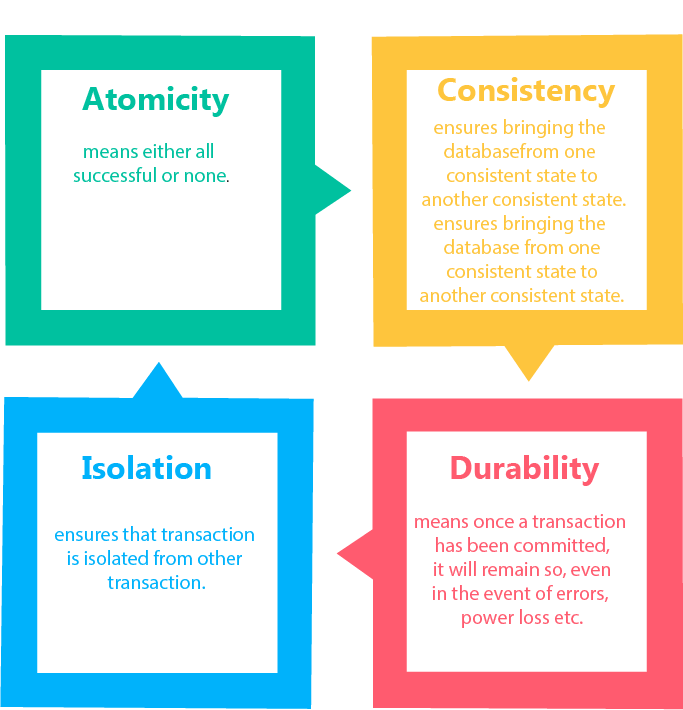Transaction property
The transaction has the four properties. These are used to maintain consistency in a database, before and after the transaction.
Property of Transaction
- Atomicity
- Consistency
- Isolation
- Durability

Atomicity
- It states that all operations of the transaction take place at once if not, the transaction is aborted.
- There is no midway, i.e., the transaction cannot occur partially. Each transaction is treated as one unit and either run to completion or is not executed at all.
Atomicity involves the following two operations:
Abort: If a transaction aborts then all the changes made are not visible.
Commit: If a transaction commits then all the changes made are visible.
Example: Let's assume that following transaction T consisting of T1 and T2. A consists of Rs 600 and B consists of Rs 300. Transfer Rs 100 from account A to account B.
| T1 |
T2 |
Read(A)
A:= A-100
Write(A) |
Read(B)
Y:= Y+100
Write(B) |
After completion of the transaction, A consists of Rs 500 and B consists of Rs 400.
If the transaction T fails after the completion of transaction T1 but before completion of transaction T2, then the amount will be deducted from A but not added to B. This shows the inconsistent database state. In order to ensure correctness of database state, the transaction must be executed in entirety.
Consistency
- The integrity constraints are maintained so that the database is consistent before and after the transaction.
- The execution of a transaction will leave a database in either its prior stable state or a new stable state.
- The consistent property of database states that every transaction sees a consistent database instance.
- The transaction is used to transform the database from one consistent state to another consistent state.
For example: The total amount must be maintained before or after the transaction.
Therefore, the database is consistent. In the case when T1 is completed but T2 fails, then inconsistency will occur.
Isolation
- It shows that the data which is used at the time of execution of a transaction cannot be used by the second transaction until the first one is completed.
- In isolation, if the transaction T1 is being executed and using the data item X, then that data item can't be accessed by any other transaction T2 until the transaction T1 ends.
- The concurrency control subsystem of the DBMS enforced the isolation property.
Durability
- The durability property is used to indicate the performance of the database's consistent state. It states that the transaction made the permanent changes.
- They cannot be lost by the erroneous operation of a faulty transaction or by the system failure. When a transaction is completed, then the database reaches a state known as the consistent state. That consistent state cannot be lost, even in the event of a system's failure.
- The recovery subsystem of the DBMS has the responsibility of Durability property.
| 
 For Videos Join Our Youtube Channel: Join Now
For Videos Join Our Youtube Channel: Join Now










